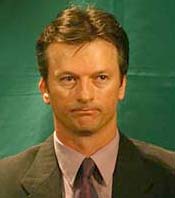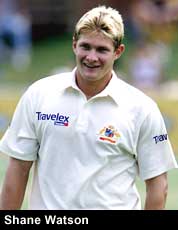A new Australia
Daniel Laidlaw
Australia will start the one-day series in South Africa from March 22 with
the maximum number of questions over its form and future since Steve Waugh
assumed the one-day captaincy four years ago. Making the uncertainty of the
reigning World Cup champions particularly unusual is that it is entirely
self-imposed.
Typically, transformation is precipitated by a period of unacceptably poor
performances. For the Australian selectors, all it took was one mediocre
tournament in which the team won half its matches and the suspicion that it
was in need of new direction.
No one can accuse them of not having a plan. It seems that despite an
unparalleled winning record (36 wins from last 50 games) the selectors were
seeking to regenerate an aging team and missing the lucrative home finals
provided the first convenient excuse.
With the World Cup a year away, the seven-match one-day series in the host
nation, South Africa, followed by three in Zimbabwe was viewed as the
perfect time and place to begin planning ahead. While the length of time
between now and the tournament allows for emergency personnel or leadership
changes if anything misfires, Australia's World Cup preparation is
officially underway.
 In itself, the three changes to the squad that failed to make the home
tri-series finals is not especially radical. The surprise is that two of
those changes are players worth a combined 569 games of ODI experience and
one or both have been fixtures in the team since 1986. An Australian one-day
team without a Waugh will be like a cricket match without stumps. They are
part of the environment.
In itself, the three changes to the squad that failed to make the home
tri-series finals is not especially radical. The surprise is that two of
those changes are players worth a combined 569 games of ODI experience and
one or both have been fixtures in the team since 1986. An Australian one-day
team without a Waugh will be like a cricket match without stumps. They are
part of the environment.
Considering Steve moulded all aspects of the Australian team to his beliefs,
the greatest impact of their sackings is undoubtedly not the loss of either
he or Mark as batsmen - neither seemed as integral as they once were, mainly
because they are no longer depended upon as much - but of Steve as captain
and both as senior dressing room figures. Their absence leaves the one-day
team, if not branching off in an entirely new direction, then at least
heading into the unknown.
Nobody can know be sure how temperamental 27-year-old Ricky Ponting, with
minimal leadership experience, can manage the limited-overs half of
Australia's two cricket teams. Unlike the veteran Waugh, in Ponting's tenure
as an international cricketer he has not experienced any truly depressed
times team-wise, and how he copes if and when they occur is the great
unknown. It would have been that way for whoever replaced Waugh, as no one
else has played in the eighties.
The direct impact of the changes is this: Ponting replaces Steve Waugh as
captain, Hayden replaces Mark Waugh as specialist opener, and Shane Watson
becomes the middle order bat and all-rounder that Steve Waugh used to be.
Shane who? The 20-year-old Watson has seemingly been earmarked to become the
new face of Australian cricket. A youth star and cricket academy product,
Watson controversially defected from his native Queensland last season to
win an immediate place in the Tasmanian team. An all-rounder, he has
exhibited rare confidence for a young Australian player, quoted recently as
saying his goal was to "bat at No. 4 and bowl first change" when most young
players when asked where they would like to play would typically say
"anywhere they want me to bat."
Having only been on the first-class scene two seasons, Watson is virtually
unknown to Australian cricket audiences. More advanced as a batsman than
fast-medium bowler at this point, his first-class statistics (13 matches,
batting average 43.81; 36 wickets at 24) are undeniably impressive.
 There can be no greater pressure on promising young cricketers than if they
are all-rounders, as they inevitably draw comparisons to whoever the last
great was. In Australia's case, it was Keith Miller in the 1950s. Evidently
seen as both a future Test and one-day player, Watson was included as the
15th player in the Test squad to South Africa to gain experience with the
national team. With the one-day team, he is likely to be tested immediately
at No. 7.
There can be no greater pressure on promising young cricketers than if they
are all-rounders, as they inevitably draw comparisons to whoever the last
great was. In Australia's case, it was Keith Miller in the 1950s. Evidently
seen as both a future Test and one-day player, Watson was included as the
15th player in the Test squad to South Africa to gain experience with the
national team. With the one-day team, he is likely to be tested immediately
at No. 7.
The other young player selected, 20-year-old off-spinner Nathan Hauritz,
will probably play a role similar to that of Watson with the Test squad. In
an expanded squad of 15, he is there as the "project" player, someone
targeted for development as a future national player. On last year's Ashes
tour, left-arm quick Nathan Bracken filled a similar role, replaced by
another young seamer in Ashley Noffke when he was hurt.
Since Shane Warne was retained - every player was supposed to have been
scrutinised, and after taking 6 wickets at 54 in home ODIs it's hard to
believe there was not at least some debate about Warne's future - Hauritz's
opportunities will probably be limited, as Australia are unlikely to play
two spinners in any game. But if the goal is for him to be part of the World
Cup squad, a back up in case Warne breaks down or loses form, then he should
play at some point to gain experience.
28-year-old opener Jimmy Maher has been a prolific scorer for Queensland at
domestic level and it appears his selection as reserve opener is reward for
that. Despite Gilchrist's poor run as an opener recently, he is still the
best option at the top of the order, able to propel Australia to an
explosive start on any given day. If he were to drop down the order to allow
Maher to open, another batsman would have to be dropped, an unfavourable
proposition. One suspects Maher is there as cover for Hayden, or in case
Gilchrist's role as an opener does become untenable.
Since winning belated selection to Australia's one-day squad in India after
his superlative Test series there, Matthew Hayden has suffered from lack of
opportunity or inconsistent selection. He has a superb record as a domestic
one-day opener, looked perfectly capable of carrying over his Test form in
the one-dayers in India, but with Waugh-Gilchrist the preferred combination
has found opportunities scarce.
In last year's tri-series in England - where he had an ordinary tour
anyway - Hayden could only manage eight runs from three outings. Then in the
home tournament, he got rotated in for two matches, failed to capitalise
under pressure with scores of 10 and 10, and was dropped. Now that he should
receive a fair opportunity to prove himself in more than a handful of
successive games, there is no obvious reason why he should not be just as
successful as a one-day batsman, if he can find a comfortable game plan.
Australia's bowling attack, which also disappointed at times during the home
tri-series, has survived selectorial scrutiny. Happily, it is identical to
the Test attack, with McGrath, Gillespie, Lee and Warne the ideal
combination, with Bichel as reserve paceman and Hauritz the second spinner.
In fact, the only Test squad members not part of the one-day party - aside
from the Waughs - are Langer and the luckless Stuart MacGill.
Langer, still with a reputation as a defensive batsman even though that has
not been justified at Test level for two years now, cannot find a place,
while MacGill has a potentially excellent ODI career stuck in stats is
behind Warne as it is in Tests. In three ODIs, MacGill has 6 wickets at
17.5, and for a leg-spinner whose control is sometimes wayward has an
outstanding domestic limited-overs record of 85 wickets at 19.85. With two
leg-spinners an impossibility and young players rightly favoured over old,
his chance may never come.
Australia's one-day all-rounders have typically been serviceable rather than
exceptional. The retired Tom Moody played an under-rated role at the last
World Cup and since then Australia has vacillated between Ian Harvey, Andrew
Symonds and Shane Lee. Harvey is a useful bowler whose batting has
disappointed, Symonds a genuine batsman whose medium pace or off-spin
bowling is manufactured rather than natural, and Shane Lee's skills are
better balanced but he has never quite excelled enough in either discipline
to become a permanent player. Of the three, Symonds has been the most poorly
treated, apparently left out on the basis of a mere three innings.
Now, there is the untried Watson, and while Harvey is the other all-rounder
in the squad it does appear that the position is Watson's to lose.
One other recalled player is Darren Lehmann, who returned for the final
preliminary game of the tri-series, made a calm 49 not out, and has earned
another opportunity as a one-day player. Widely regarded as the best batsman
in Australia not playing Test cricket, the 32-year-old Lehmann has
squandered chances before and should be keen to secure a role ahead of
younger players. Despite his age and lack of fielding prowess, Australia is
better for his inclusion. Perhaps the only negative is that his selection
means Australia's top six contains four left-handers.
So with several areas of uncertainty - Ponting's captaincy foremost, Watson'
s ability to adjust to international cricket and how the loss of the
experienced Waughs affects the batting and leadership generally - the
immediate future of the Australian one-day team suddenly hinges on the next
10 ODIs. With the selectors having deliberately sought rejuvenation as they
prepare a side for the World Cup, all players are in the unfamiliar position
of having to prove themselves again. They have done so before.
Ideal 'new' Australian XI:
Adam Gilchrist,
Matthew Hayden,
Ricky Ponting (c),
Damien Martyn,
Darren Lehmann,
Michael Bevan,
Shane Watson,
Shane Warne,
Brett Lee,
Jason Gillespie,
Glenn McGrath.
More Columns
Mail Daniel Laidlaw